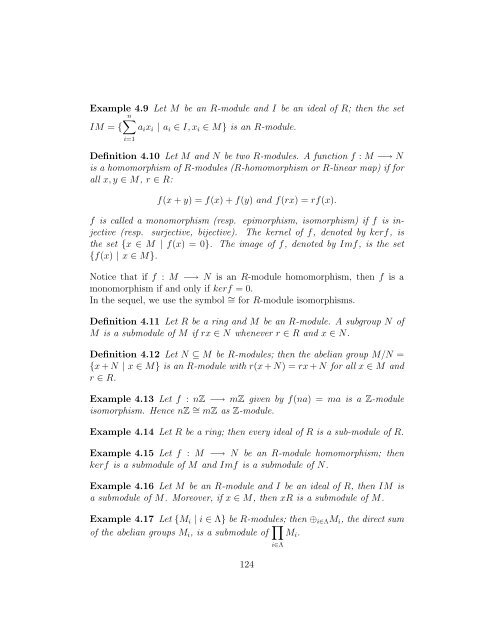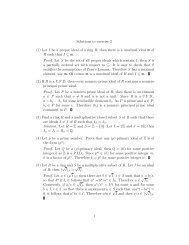Topics in algebra Chapter IV: Commutative rings and modules I - 1
Topics in algebra Chapter IV: Commutative rings and modules I - 1
Topics in algebra Chapter IV: Commutative rings and modules I - 1
You also want an ePaper? Increase the reach of your titles
YUMPU automatically turns print PDFs into web optimized ePapers that Google loves.
Example 4.9 Let M be an R-module <strong>and</strong> I be an ideal of R; then the set<br />
n<br />
IM = { aixi | ai ∈ I, xi ∈ M} is an R-module.<br />
i=1<br />
Def<strong>in</strong>ition 4.10 Let M <strong>and</strong> N be two R-<strong>modules</strong>. A function f : M −→ N<br />
is a homomorphism of R-<strong>modules</strong> (R-homomorphism or R-l<strong>in</strong>ear map) if for<br />
all x, y ∈ M, r ∈ R:<br />
f(x + y) = f(x) + f(y) <strong>and</strong> f(rx) = rf(x).<br />
f is called a monomorphism (resp. epimorphism, isomorphism) if f is <strong>in</strong>jective<br />
(resp. surjective, bijective). The kernel of f, denoted by kerf, is<br />
the set {x ∈ M | f(x) = 0}. The image of f, denoted by Imf, is the set<br />
{f(x) | x ∈ M}.<br />
Notice that if f : M −→ N is an R-module homomorphism, then f is a<br />
monomorphism if <strong>and</strong> only if kerf = 0.<br />
In the sequel, we use the symbol ∼ = for R-module isomorphisms.<br />
Def<strong>in</strong>ition 4.11 Let R be a r<strong>in</strong>g <strong>and</strong> M be an R-module. A subgroup N of<br />
M is a submodule of M if rx ∈ N whenever r ∈ R <strong>and</strong> x ∈ N.<br />
Def<strong>in</strong>ition 4.12 Let N ⊆ M be R-<strong>modules</strong>; then the abelian group M/N =<br />
{x + N | x ∈ M} is an R-module with r(x + N) = rx + N for all x ∈ M <strong>and</strong><br />
r ∈ R.<br />
Example 4.13 Let f : nZ −→ mZ given by f(na) = ma is a Z-module<br />
isomorphism. Hence nZ ∼ = mZ as Z-module.<br />
Example 4.14 Let R be a r<strong>in</strong>g; then every ideal of R is a sub-module of R.<br />
Example 4.15 Let f : M −→ N be an R-module homomorphism; then<br />
kerf is a submodule of M <strong>and</strong> Imf is a submodule of N.<br />
Example 4.16 Let M be an R-module <strong>and</strong> I be an ideal of R, then IM is<br />
a submodule of M. Moreover, if x ∈ M, then xR is a submodule of M.<br />
Example 4.17 Let {Mi | i ∈ Λ} be R-<strong>modules</strong>; then ⊕i∈ΛMi, the direct sum<br />
of the abelian groups Mi, is a submodule of <br />
Mi.<br />
124<br />
i∈Λ



